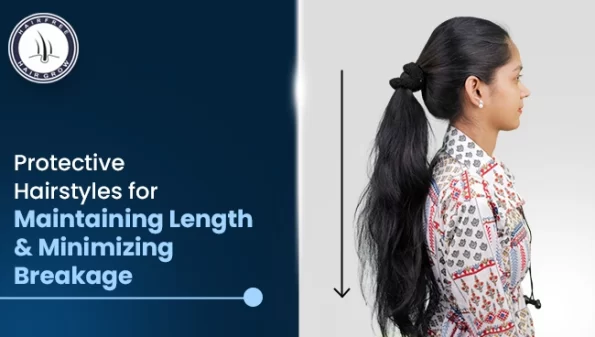When it comes to hair care, maintaining length and minimizing breakage are two major concerns for many individuals. Protective hairstyles have gained significant popularity for their ability to safeguard hair from damage while promoting healthy growth. In this comprehensive guide, we will explore various protective hairstyles that can help you maintain length and minimize breakage. From braids to twists, we’ll cover it all!
Protective hairstyles play a crucial role in safeguarding your hair from external factors that can cause breakage and stunted growth. These hairstyles not only offer protection but also give your hair a chance to rest and rejuvenate. Let’s dive into some of the most effective protective hairstyles:
1. Box Braids: Timeless and Versatile
Box braids are a classic protective style that has stood the test of time. These braids involve sectioning the hair and weaving extensions into each section. Box braids offer versatility, as they can be styled in various ways, allowing you to experiment with different looks while keeping your natural hair protected.
2. Twists: Chic and Low-Maintenance
Twists are another fantastic option for protective styling. With two-strand twists, you can create a chic and sophisticated look that requires minimal maintenance. This hairstyle keeps your hair protected and allows for easy moisturizing and care.
3. Bantu Knots: Stylish and Playful
Bantu knots are not only a stylish protective hairstyle but also a great way to achieve gorgeous curls once the knots are unraveled. This versatile hairstyle can be worn for any occasion and helps in maintaining length by keeping the ends tucked away.
4. Ghana Braids: Intricate and Elegant
Ghana braids, also known as cornrows, are an intricate and elegant protective hairstyle. This style involves weaving the hair close to the scalp in a series of small, raised rows. Ghana braids not only protect your hair but also offer endless possibilities for creative and unique designs.
5. Wigs and Weaves: Instant Transformation
Wigs and weaves are a popular choice for protective styling, as they provide a quick and easy way to switch up your look while protecting your natural hair. With a wide range of options available, you can experiment with different textures, lengths, and colors without compromising the health of your hair.
6. Halo Braids: Ethereal and Graceful
Halo braids, also known as crown braids, are a stunning protective hairstyle that creates a beautiful crown-like effect around the head. This style keeps your hair off your face and neck, reducing friction and breakage. Halo braids are perfect for special occasions or when you want to add a touch of elegance to your everyday look.
7. Updos: Stylish and Sophisticated
Updos are not only elegant but also offer excellent protection for your hair. From sleek buns to intricate styles, updos keep your ends tucked away and prevent them from rubbing against clothing or surfaces, reducing the risk of breakage.
8. Senegalese Twists: Trendy and Glamorous
Senegalese twists are a trendy and glamorous protective hairstyle that involves adding long, smooth twists to your natural hair. This style offers versatility and can be worn in various ways, allowing you to express your creativity while ensuring your hair remains protected.
Frequently Asked Questions (FAQs)
How long can I leave My hair in a Protective Hairstyle?
The duration for which you can leave your hair in a protective hairstyle depends on several factors, such as the type of hairstyle, your hair’s texture, and your scalp’s health. As a general guideline, it is recommended to keep your hair in a protective style for about 4-8 weeks. However, it’s essential to listen to your hair and pay attention to any signs of discomfort or tension. If you experience itching, pain, or excessive shedding, it’s time to take down the style and give your hair a break.
How should I Maintain My hair while it's in a Protective Style?
While your hair is in a protective style, it’s crucial to care for it properly to maximize its benefits. Here are a few tips:
Moisturize: Even when your hair is tucked away, it still needs moisture. Use a lightweight moisturizer or a leave-in conditioner to keep your hair hydrated.
Scalp Care: Pay attention to your scalp health. Cleanse your scalp regularly with a gentle shampoo or co-wash to prevent product buildup and maintain a healthy environment for hair growth.
Protect at Night: Cover your hair with a satin or silk bonnet or use a satin pillowcase to reduce friction and protect your style while you sleep.
Avoid Tension: Ensure that your protective style is not too tight, as this can cause tension and lead to breakage. If you feel discomfort or pain, it’s important to loosen or remove the style.
Can I wash my hair while it's In a Protective Style?
Yes, you can wash your hair while it’s in a protective style, but it requires a gentle and careful approach. Dilute a sulfate-free shampoo with water and apply it directly to your scalp, gently massaging to cleanse. Rinse thoroughly and follow up with a conditioner. Avoid manipulating the style excessively, as this can cause frizz or unravel the braids or twists. It’s best to consult a doctor with a professional stylist for guidance on washing your specific protective hairstyle.
How do I prevent breakage when removing a protective style?
Removing a protective style requires patience and care to minimize breakage. Here’s how you can do it:
Prepare your hair: Apply a generous amount of oil or a detangling spray to your hair before removing the style. This helps to loosen any knots or tangles and reduces the risk of breakage during the process.
Take it slow: Start by unraveling the ends of the braids or twists gently. Avoid pulling or tugging forcefully. Work your way up gradually until you’ve completely removed the style.
Detangle with care: Once the style is removed, use a wide-toothed comb or your fingers to gently detangle your hair. Start from the ends and work your way up to prevent unnecessary breakage.
Deep condition: After removing the style, treat your hair to a nourishing deep conditioning treatment to replenish moisture and restore strength.
How often should I trim my hair when practicing protective styling?
Trimming frequency depends on your hair’s condition and individual needs. However, a general recommendation is to trim your hair every 8-12 weeks or as needed. Trimming helps to get rid of split ends and prevents them from traveling up the hair shaft, leading to further breakage. Regular trims contribute to maintaining length and promoting healthy hair growth.
Can anyone wear protective hairstyles?
Protective hairstyles are suitable for most hair types and lengths. However, it’s important to consider your hair’s health and condition before opting for a specific style. If you have anyexisting scalp or hair conditions, it’s best to consult with a professional stylist or dermatologist to determine the most suitable protective hairstyles for you. Additionally, it’s essential to ensure that the style is not too tight or causing excessive tension, as this can lead to breakage or damage. Always prioritize the health and well-being of your hair when choosing and wearing protective hairstyles.
Conclusion
Protective hairstyles are a fantastic way to maintain length and minimize breakage while giving your hair a break from daily styling. Whether you opt for braids, twists, or updos, these hairstyles offer both protection and versatility. Remember to choose a style that suits your hair type and comfort level, and always prioritize proper care and maintenance while your hair is in a protective style. With the right approach, you can achieve healthy, long, and beautiful hair while minimizing breakage.
Written By
MBBS, DDV
Dr. Sanjay Sharma is a seasoned trichologist specializing in understanding protective hairstyles for maintaining length and minimizing breakage. With years of experience, she guides her patients on choosing braids, twists, buns, and updos that not only protect their hair but also promote healthy growth. Dr. Sharma’s expertise ensures that your locks stay strong and stylish, even in challenging conditions.
Disclaimer
We’ve made all possible efforts to ensure that the information provided here is accurate, up-to-date and complete, however, it should not be treated as a substitute for professional medical advice, diagnosis or treatment. See Detailed Disclaimers Here.


